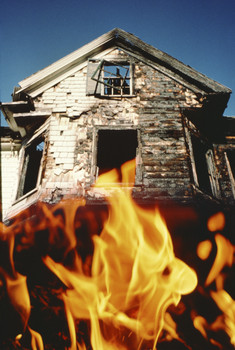Jun 11 2009
It is widely understood by firefighters and other first responders that if a fire has been burning in a home for more than five minutes, and that home is constructed with engineered I-joist flooring systems, you are literally putting your life on the line by entering the home in order to assist residents in escaping and getting the fire under control. This is because of the tendency of these engineered wood flooring systems to burn rapidly and fail quickly when a fire breaks out.

In contrast, it has been a commonly held belief of firefighters that solid lumber flooring components provide approximately 30-minutes of safety before the risk of collapse reaches an unacceptable level. This has lead to a call among firefighters in many communities throughout the United States to find a way to "get my 30-minutes back."
For years, as lightweight construction methods have gained wide use in residential structures, leaders in the fire service community have brought this problem to the attention of those responsible for creating and adopting building codes at the federal, state and local level. Without a solid method to enhance the fire safety of these materials, however, little or nothing has been done. That may all be about to change!
Fire Safety Instructors from Waukesha County Technical College in Pewaukee, Wisconsin, recently worked with their peers and students from the carpentry group to show how an intumescent coating known as No-Burn Plus intumescent paint can dramatically expand the time available for residents to reach safety and firefighters to perform required tasks in a home that has caught on fire. They constructed two 8-foot by 8-foot simulated flooring systems using 12-inch wooden I-joists 24-inches on center and 1-inch oriented strand board (OSB) floor decking. Both floors were elevated three feet above the ground by concrete blocks, and each was covered with a ½-inch layer of cement board and then loaded with 418 pounds of concrete blocks to simulate the weight of two firefighters. One of these flooring systems was left untreated, while the other received a coating of No-Burn Plus intumescent paint. Flame was applied to the underside of both flooring systems by a propane torch with multiple gas outlets to simulate a fire originating in the basement level of a home. The initial failure of the I-joist system of the untreated floor occurred at about 15 minutes, at which point the flame source was removed. Total failure of the untreated structure occurred around the 33 minute mark. In contrast, the flame was removed from the treated structure at the 38 minute point and little to no damage had occurred - it had become obvious to the participants in the demonstration that the treated system would continue to remain in place for a great deal of additional time. Upon removal of the flame source, any fire evident on the treated structure self extinguished.
"This is a significant development for occupants of residential structures and firefighters alike," said Robert Davidson of Davidson Code Concepts, a nationally recognized fire and building code compliance consulting firm. According to Davidson, "Fire service professionals have been seeking methods of protecting against flooring and roofing system collapse ever since the use of lightweight construction methods have gained increased use in residential construction. This appears to be a fairly inexpensive and a highly effective method of dramatically increasing the time before these structural systems would be expected to fail in the event of a fire in the structure."
"We started a process of exploring the hazards of lightweight construction in typical residential construction last year," said Dr. Thomas Schlei, Fire Training Instructor at Waukesha County Technical College. "As an extension of that process we decided to compare the effect of fire impingement on typical lightweight construction structural materials, both uncoated and coated with an intumescent paint material such as the No-Burn Plus coating. In the demonstration burn that we conducted it was apparent that the intumescent paint coating did provide a significant amount of protection to the wooden I-joist and underside of the floor decking materials. This could potentially buy time for occupants to escape and possibly extend structural integrity for firefighters to conduct fireground operations. We are very proud of our students and staff, and quite pleased that our academic program has been able to provide an effective public service related to enhancing fire safety with respect to understanding lightweight construction."